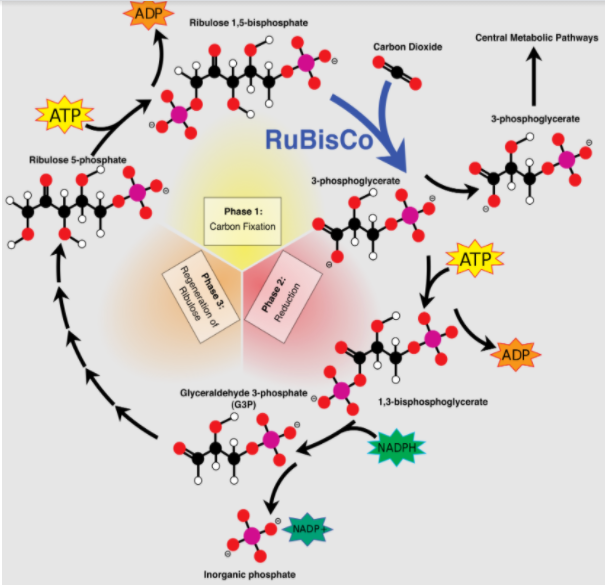
In photosynthesis $CO_2$ combines with
A) RUDP or RUBP
B) ATP
C) ADP
D) PGA
Answer
517.8k+ views
Hint: Photosynthesis is the process by which the plants prepare glucose using carbon dioxide and water. The fixation of carbon dioxide into glucose takes place during the dark reaction of photosynthesis. This reaction needs energy molecules produced in the light reaction. The dark reaction is also known as carbon reduction cycle.
Complete answer:
To answer this question, we must know about the dark reaction of photosynthesis. During the light reaction, the light energy is utilised to produce the energy molecules like NADPH and ATP. In dark reactions which take place in the absence of light, the energy molecules produced in the light reaction are consumed to synthesize carbohydrates.
The dark reaction or the Calvin cycle takes place in three steps-
- Carbon fixation- In this step, carbon dioxide combines with RUBP or RUDP in the presence of enzyme RUBISCO. This generates PGA or phosphor-glyceric acid.
- Reduction- In this step the PGA is reduced in the presence of ATP and NADPH to produce glyceraldehyde 3 phosphate.
- Regeneration- In this step the RUBP is regenerated by using ATP which is available for accepting the next carbon dioxide.
- ATP and ADP are Adenosine tri phosphate and biphosphate. It is produced during light reaction. It is consumed during the reduction and regeneration phase.
- PGA- Phospho-glyceraldehyde is a 3C compound which is produced as a result of carbon dioxide fixation.

Thus the correct answer is option ‘A’.
Note: The dark reaction is the biochemical phase of the photosynthesis which takes place in the stroma of chloroplast. The glucose is the end product. Each molecule of carbon dioxide requires 3ATP and 2NADPH.
Complete answer:
To answer this question, we must know about the dark reaction of photosynthesis. During the light reaction, the light energy is utilised to produce the energy molecules like NADPH and ATP. In dark reactions which take place in the absence of light, the energy molecules produced in the light reaction are consumed to synthesize carbohydrates.
The dark reaction or the Calvin cycle takes place in three steps-
- Carbon fixation- In this step, carbon dioxide combines with RUBP or RUDP in the presence of enzyme RUBISCO. This generates PGA or phosphor-glyceric acid.
- Reduction- In this step the PGA is reduced in the presence of ATP and NADPH to produce glyceraldehyde 3 phosphate.
- Regeneration- In this step the RUBP is regenerated by using ATP which is available for accepting the next carbon dioxide.
- ATP and ADP are Adenosine tri phosphate and biphosphate. It is produced during light reaction. It is consumed during the reduction and regeneration phase.
- PGA- Phospho-glyceraldehyde is a 3C compound which is produced as a result of carbon dioxide fixation.

Thus the correct answer is option ‘A’.
Note: The dark reaction is the biochemical phase of the photosynthesis which takes place in the stroma of chloroplast. The glucose is the end product. Each molecule of carbon dioxide requires 3ATP and 2NADPH.
Recently Updated Pages
Why are manures considered better than fertilizers class 11 biology CBSE

Find the coordinates of the midpoint of the line segment class 11 maths CBSE

Distinguish between static friction limiting friction class 11 physics CBSE

The Chairman of the constituent Assembly was A Jawaharlal class 11 social science CBSE

The first National Commission on Labour NCL submitted class 11 social science CBSE

Number of all subshell of n + l 7 is A 4 B 5 C 6 D class 11 chemistry CBSE

Trending doubts
Differentiate between an exothermic and an endothermic class 11 chemistry CBSE

10 examples of friction in our daily life

One Metric ton is equal to kg A 10000 B 1000 C 100 class 11 physics CBSE

Difference Between Prokaryotic Cells and Eukaryotic Cells

1 Quintal is equal to a 110 kg b 10 kg c 100kg d 1000 class 11 physics CBSE

State the laws of reflection of light




